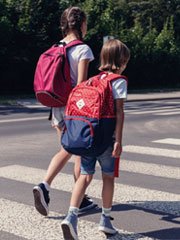Bike and Pedestrian Safety

Playing outside can be fun for all ages, but being safe while at play is the key! Teaching children safe behaviors while riding their bike, crossing the street or while on the playground can help keep them safe during playtime.
Helmets Save Lives
Helmet Safety Program
Please call Cottage Trauma Services at 805-569-7451 to learn more about our helmet safety program. We are dedicated to providing helmets to our community at little to no cost for those in need.
Your child’s head is one of the most important parts of their body and that’s why it’s important to make sure they always wear their helmet before heading out for a bike ride. Wearing a helmet is the best protection to preventing head injuries and can even save a child’s life!
- A helmet is considered safe if it has a sticker inside or if the box states that it was certified by the Consumer Product Safety Commission (CPSC)
- Never buy or use a second-hand helmet. It may be too old to protect your child’s head or it may have been involved in a crash
- Always take the child to the store when purchasing a helmet to ensure proper fit
- Be a good role model and make sure to always put on your helmet each time you get on your bike
Follow this link to take the Helmet Fit Test
Skating and Skateboarding
More than 82,000 people are treated in the hospital emergency rooms for skateboard-related injuries every year. Skateboarding injuries can range from mild to life-threatening. Skateboarders have been killed by head injuries and collisions with cars.
- Every skater should wear a helmet. Wrist guards, knee pads and elbow pads are a good idea for everyone, but especially for beginners. Mouth guards are good protection against broken teeth
- Find the right helmet fit
- Buy skates that truly fit in order to make learning easier and safer for your child
- Limit skating to bike paths or areas set aside in public parks
- Streets should be off-limits, as most in-line skating fatalities involve collisions with motor vehicles
- Teach children to minimize the impact of a fall by crouching down as they lose balance to reduce the distance to the surface
- According to the American Academy of Pediatrics (AAP), children under 5 should never ride a skateboard
Pedestrian
Teaching your child to be safe near streets can help prevent injuries! Teenagers are now the most at-risk group for pedestrian injuries. Make sure they are not distracted with hand-held devices or headphones while walking. They should be concentrating on their surroundings to make sure they’re safe while walking.

- Teach your child to always look left, right and left again before crossing the street to make sure a car is not coming.
- Children shouldn’t walk alone or cross the street by themselves until they are at least 10 years of age.
- Teach your child the street signs and their meanings, including:
- STOP
- WALK
- DON'T WALK
- Red, Yellow & Green stoplight signals
- Teach your child to always cross at the cross walk, even if it means having to walk further down the street to get to the next cross walk. Safety is more important!
- Always tell your child to never dart across a busy street to try and beat an oncoming car. They may trip and fall into the street or the car may be driving faster than they realize.
- A child should make eye contact with drivers prior to crossing in front of them to make sure the driver of the car saw them.

